
Join the tribe of Movement & Calisthenics Athletes – people just like you that are working with their own body weight to get strength, lose fat build muscle, recover from injuries and live their best lives!
Pretty much every guy out there wants to fulfill his muscle gaining potential.
There’s a LOT of good reasons for this – both emotional and scientific.
For example, on the emotional end, gaining muscle can help you:
– Feel more confident
– Impress the ladies and have a better dating life
– Get other guys to take you more seriously
It’s not politically correct, but it’s true:
Being more muscular will help you both in the boardroom AND in the bedroom.
The Career Benefits of Gaining Muscle
I mean, just imagine this:
You’re the CEO of a company.
You walk into a room, and makes a pitch.
Imagine, for one second, you weigh about 120 pounds soaking wet, as you try to command attention.
Then, imagine how it would feel to be as muscular as humanly possible – while being pretty lean.
For most guys, this would be around 180-190 pounds.

Don’t you think there will be a MASSIVE difference in how successful you’ll be as a businessman?
Like it or hate it, people who are muscular are taken more seriously, and regarded as more competent.
The Dating Benefits of Gaining Muscle

Gaining muscle is probably even MORE important for most guys when it comes to dating.
Make no bones about it, ladies love muscle.
If you’re muscular, it means that you take care of yourself, that you’re healthy, and that you can work hard and stay consistent.
It means that you’re going to be able to fight off would-be attackers more easily.
And, it just makes you look more handsome.
The Health Benefits of Gaining Muscle

Image credit: Ryderwear [https://au.ryderwear.com]
Plus, lean muscle mass is REALLY good for your health.
Studies show that a big correlation between how much muscle mass you have and how long you live.
As Dr. Arun Karlamangla states, “The greater your muscle mass, the lower your risk of death,” citing research from UCLA.
And, lean muscle mass increases your metabolism, which means that you can eat more food without gaining weight.
Since obesity and heart disease are some of the top risk factors for modern men, gaining muscle is just plain smart.
The Personal Benefits of Gaining Muscle
All those external reasons are great.
But there’s one MAIN reason you should try to get as muscular as you are able to get.
You’ll feel more confident.
There are many things you can’t control in life.
But, you can control your training, nutrition, and recovery habits.
Which means:
In the long run, you ABSOLUTELY can control how muscular you are.

And so no matter what else happens in your life…
If you commit to gaining muscle, you’ll experience the benefits of hard work and dedication, as they make you into a stronger, more powerful, more advanced version of yourself.
Pretty badass, huh?
Mistakes most guys make trying to gain muscle with calisthenics
However, there are some really basic mistakes that guys make over and over again when they’re trying to gain muscle with calisthenics.
If you make even one of these mistakes, you won’t see results…
You’ll spend hours and hours in the gym, eat till you feel sick, and still not gain muscle.
Now, don’t get us wrong – some guys just think about doing a pushup, and gain muscle.
But if you’re reading this, that’s probably not you.
You’re probably a normal muscle gaining type, or maybe even a hardgainer.
Hardgainers are guys who seem to have trouble gaining muscle no matter what – they often are skinny, easily gain fat, and have small joints, as well as being stressed out all the time.
If you’ve always struggled to gain muscle – have no fear.
We’re going to be giving you hardgainer specific advice throughout this article.
And just remember: if you’re a hardgainer, you don’t have the luxury of half assing things. You gotta get the fundamentals right CONSISTENTLY if you want to see results.
There are 3 big mistakes most guys make when trying to gain muscle:
- They go too hard, too fast, and not consistently enough
- They don’t eat enough – or eat too much junk
- They are stressed out and tired – sabotaging their gains
If you make even one of these mistakes, your muscle gain efforts as a hardgainer are FUCKED.
Luckily, you’re about to learn how to gain muscle the right way with calisthenics.
Fair warning: this article is quite long.
It is the ultimate guide after all.
So make sure to sign up for our FREE email course, the “School of Strength” right now so you don’t forget.
You’ll learn the secrets to becoming incredibly strong and mobile – which is KEY for gaining muscle.
Alright, let’s get back into it.
There are 3 laws of muscle gain you MUST follow if you want to get jacked:
- TRAINING: You must TRAIN WITH PROGRESSIVE OVERLOAD– without getting injured
- DIET: You must eat enough calories – and eat mostly whole foods
- LIFESTYLE: You must get lots of sleep – and manage your stress levels
Let’s first have a look at the training module and how to train calisthenics for maximum muscle gains.
PART 1: TRAINING
HOW TO TRAIN WITH CALISTHENICS FOR MAXIMUM MUSCLE GAINS
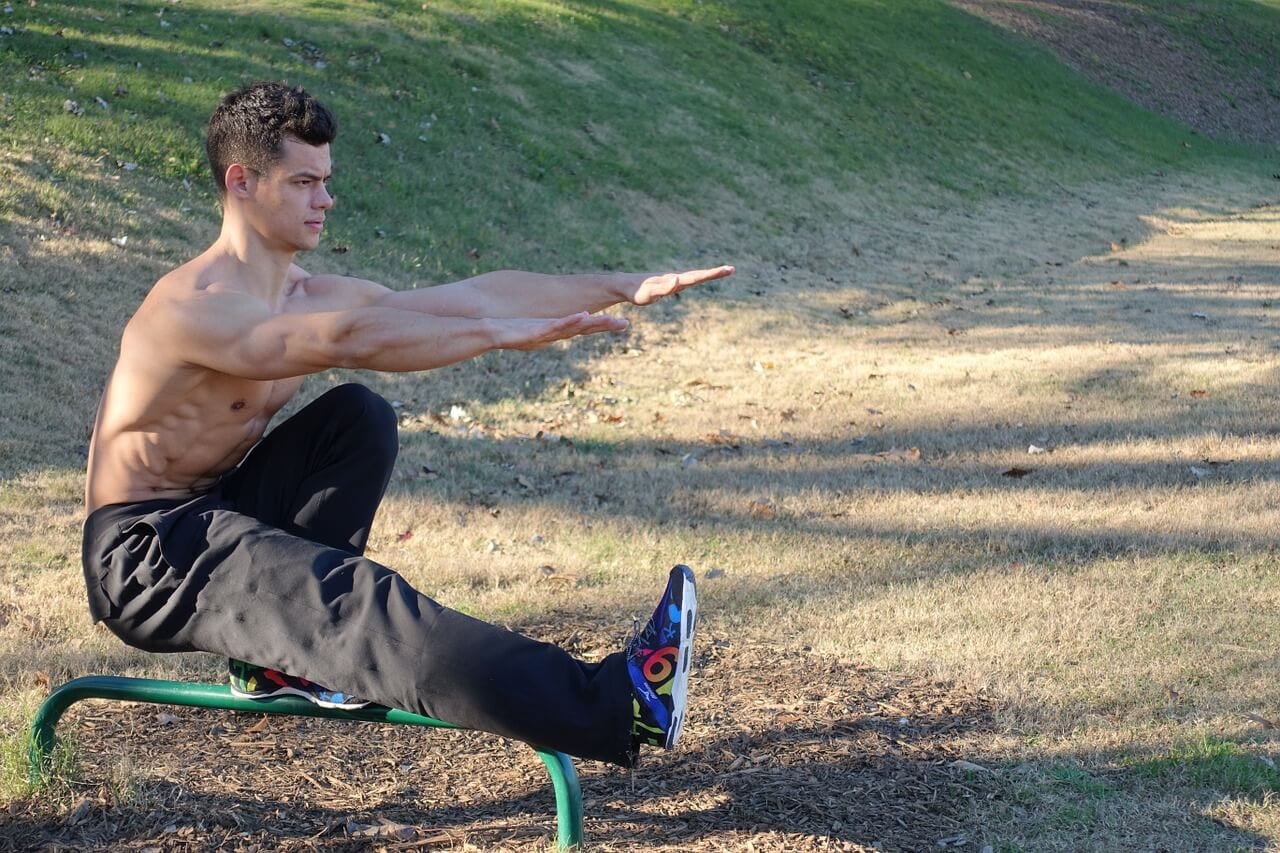
Let’s get right to the meat of it: the best way to build muscle is to get as strong as hell.
Here’s why: your body is a survival machine.
It adapts to what you throw at it.
When you work out, you challenge your muscles, and literally break down the muscle fiber.
Since your body adapts, when your muscles recover, your body “overcompensates” and builds them up even stronger than they were before.
This means you have only one goal with your training: get better each and every week.
As in, more reps, or harder movements, or better form.
Each and every week.
The key is to make sure you are pushing yourself, but not pushing yourself so hard that you risk injury, or use shitty form.
That’s counterproductive.
Is calisthenics really good for gaining muscle?
Calisthenics is really good for gaining muscle, especially in your upper body, and especially if you’ve dealt with joint pain or just aches and pains in the past.
Don’t get us wrong, weight lifting can be great for building muscle as well.
But it tends to beat up your joints a lot.
And when you’re injured, or in pain, you obviously can’t train properly and gain muscle.
Calisthenics, done properly, is very progressive in nature and will help increase your mobility and build bulletproof joints that resist injury.
Which means you can keep training, keep getting stronger, and keep building muscle.
Final word: if you’re in doubt about how jacked you can get with calisthenics, just check out these gymnasts and see for yourself:
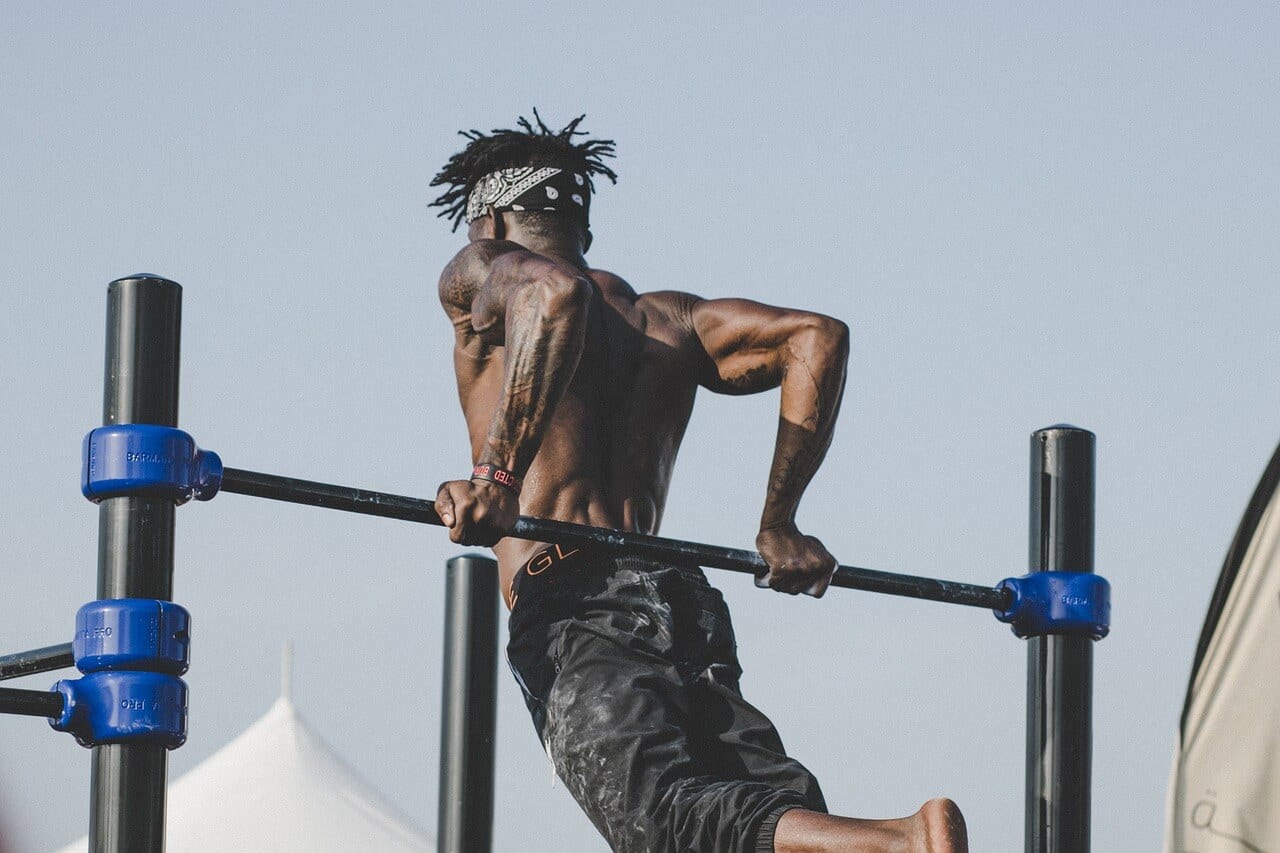
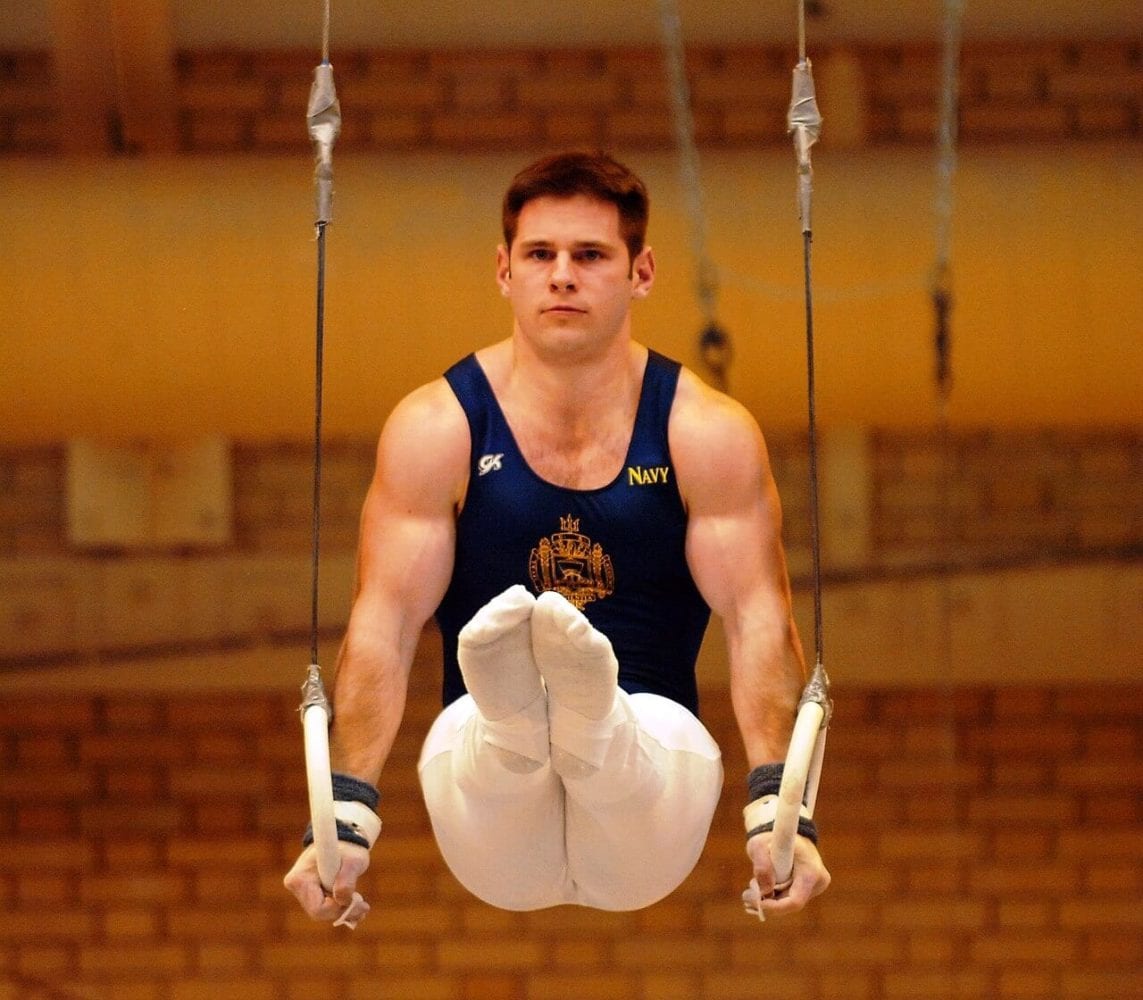
The only thing that you might still want to use weights for is for building your legs.
You can do lots of leg stuff with calisthenics, but at some point in your career, you should up the resistance do some heavy sled pushes.
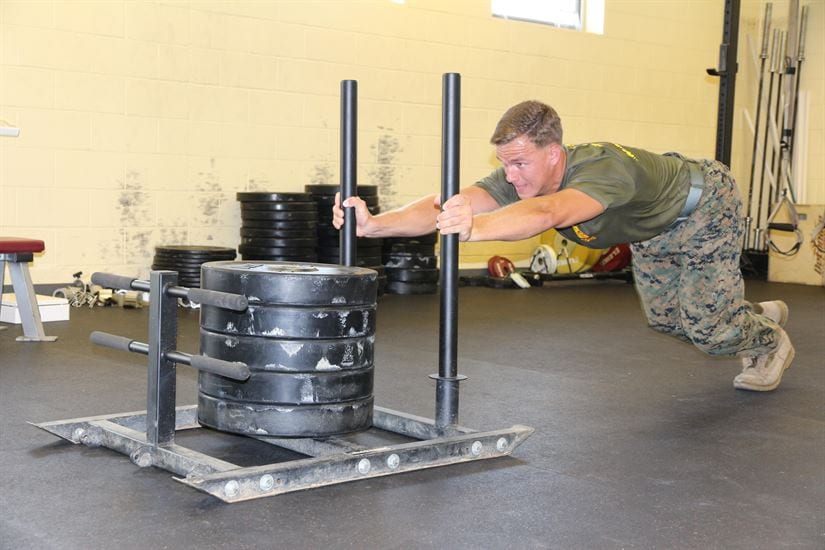
What physique will you get with calisthenics
Yes, you can build muscle with bodyweight training.
However, there are a few things you should know.
What kind of physique you are going after?
If you want to a bodybuilder type – you will have to use weights. The unnatural bodybuilding look can be achieved only with weight training and if that is your goal weight training is what you should do.
If you’re after a well balanced muscle, gymnast like physique bodyweight is the answer but you still need to train and eat for it.
Weight training (kettlebells, sandbags can do the work too) is slightly superior to bodyweight training for hypertrophy, because it’s easier to incrementally increase resistance and we have seen a lot of athletes combined the two. But, you really don’t have to.
You can build big muscle mass with bodyweight training, and unlike with extreme weight training, it will look natural, and you will be more likely to avoid potential lifelong injuries.
What kind of calisthenics is best for muscle gain?
Not all calisthenics programs are created equally.The main thing you want is a program that is completely customized and adapted to you, with tons of “micro progressions” so that you can continuously get 1% stronger without injury.
Other programs (such as the popular Convict Conditioning) are awesome, but some of them have “too big” of a difficulty increase between progressions.
Which means: you get stuck.
So, what’s a guy to do? It’s way too much effort and learning to create your own plan. And hiring a 1 on 1 trainer, while amazing, can be pretty pricey.
That’s why we created The Movement Athlete Academy: it uses assessments and an AI powered algorithm to give you workouts that are completely customized to you.
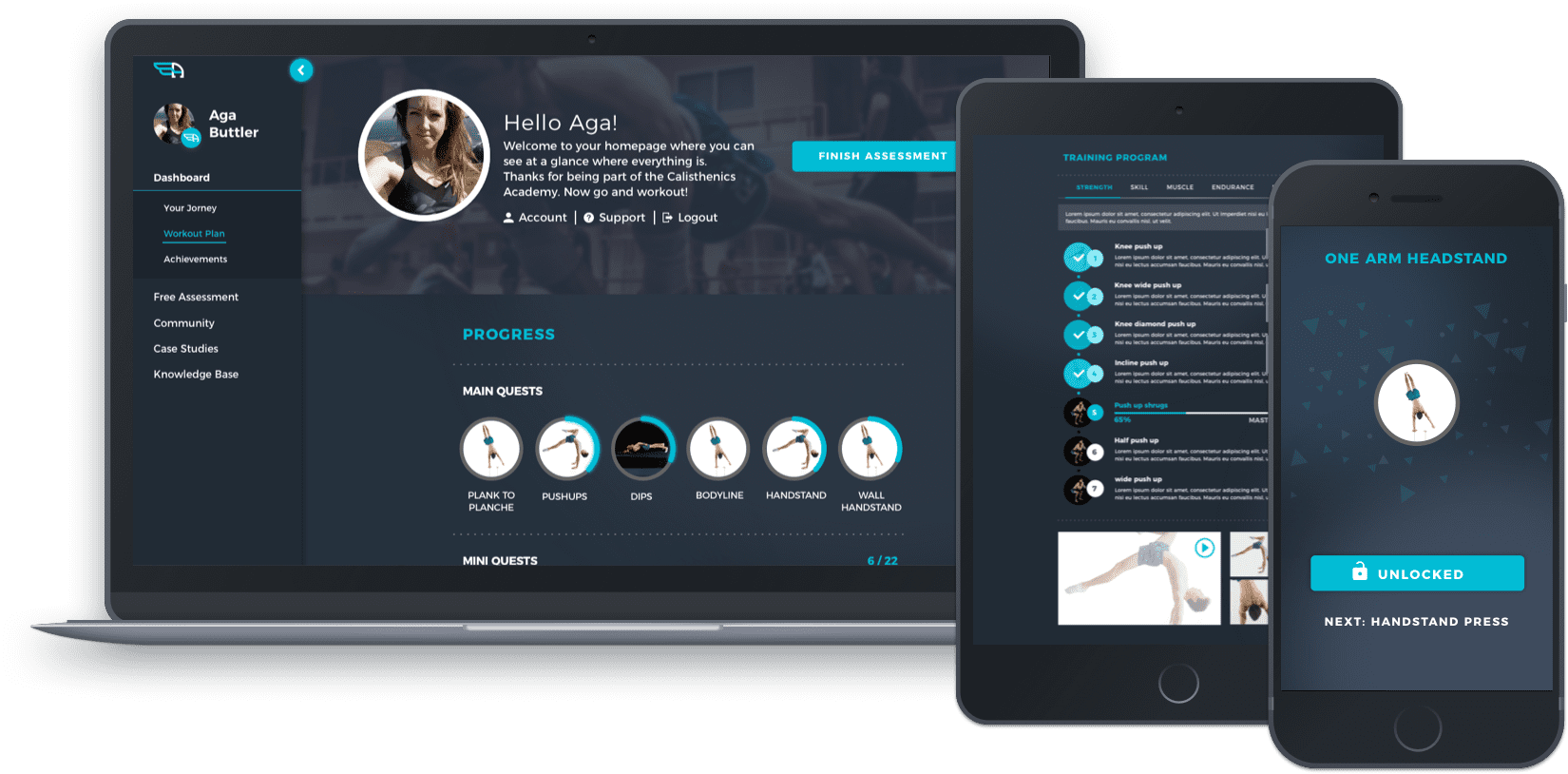
Every workout adapts to your current energy level – so, if you’re having a tough day, the workout automatically gets easier.
And if you’re killing it, the workout keeps the good stuff coming and ups the level a bit.Plus, there are videos for each and every movement, so that you always know how to use good form – and prevent injuries.
Additionally good calisthenics training program will involve these principles
Principle 1: Amount Of Time Under Tension
Principle 2: Amount Of Tension Under Tension
Principle 3. Progressive Overload
Principle 4: Reduce the speed & Squeeze During
Contraction
Creating your own training program
Where to Start:
Depending on where you are in on your journey you should start with fundamental movements. Here is the list of all of them and you can access them all for free by registering here.
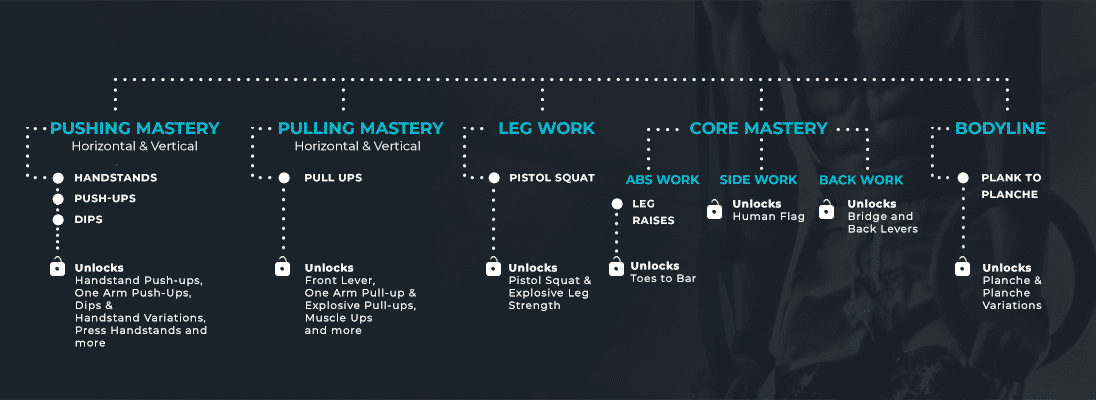
calisthenics fundamentals
For each of the fundamental progressions you should choose a progression that you can do for 3 sets of 8 to 12 reps of each exercise.
Sets and Reps: You want to go after high-volume, multiple-set programs (6 to 12 reps, 3 to 6 sets). This has been shown to create greater hypertrophy for two important reasons.
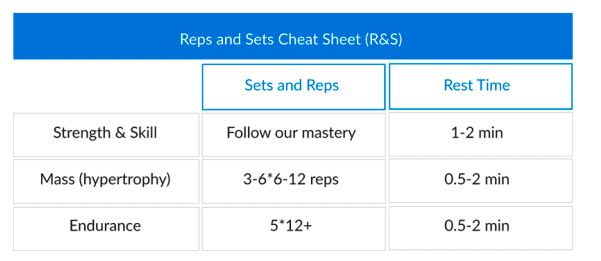
The higher workload is more effective at creating micro-trauma, tiny muscle tears that stimulate increased protein synthesis, and therefore muscle growth. High-volume, multiple-set programs are also more effective at increasing the body’s production of testosterone and growth hormone (Kraemer et al, 1991; Kraemer et al 1990). Those elements are all you need to cause hypertrophy.
Rest Periods: The rest time between sets should be between 30 to 90 seconds, and nothing more than that.
How many sessions a week?
With calisthenics, 3-4 sessions a week is about right. You can experiment with more, but start here. And if you’re not getting stronger week to week, back off!You want to feel fresh and energized at each workout, ready to get a little bit better every time. Because that’s how you get stronger, and that’s how you develop bigger muscles.Again, getting stronger doesn’t just mean more reps. It also often means doing a harder progression than the last time.
How to not get stuck: Periodization
Now, there’s one thing you should be aware of. High volume and multiple sets might pack on muscle quickly, but you shouldn’t ONLY train this way.
Training this way exclusively will get you stuck in “general adaptation syndrome,” which means your body will adapt to the program very quickly and you’ll run into a massive plateau.
An effective, scientifically-proven way to pack on muscle quickly is to use a periodized routine that emphasizes high volume and multiple sets—that is, a plan that intersperses hypertrophy workouts with regular strength-focused workouts.
The periodic variation lets you beat your body’s adaptive tendencies by changing the number of sets and reps of the program, boosting muscle growth. Sets and reps can be varied per exercise, per workout, or per week.
For example, a solid routine using periodization on a per-workout basis could be a 2-to-1-hypertrophy/strength rotation. This means that you do 2 hypertrophy workouts (8 to 12 reps, 6 sets) for every 1 strength workout (4 to 6 reps, 3 sets). I’ve learned that slotting in a strength day helps me lift more on my hypertrophy days.
How quickly can you gain muscle?
The amount of muscle a person can gain in 12 weeks varies greatly according to their level of training experience, genetics and natural abilities. For this question, I’m going to presume the person is a beginner.
As a new weight trainee, they will notice an increase in strength. Hypertrophy won’t be very noticeable until about the 6th to 10th week.
I have seen people put on 10kg of muscle in 12 weeks … but they were previously trained individuals who were coming back to training after a long time off and knew exactly how their body works and what to do for that.

Your goal should be to get 1% stronger every workout.
Sure, some days you may have a bad day, and be tired.
But if you’re not getting stronger week to week, you’re either doing way too little, or (more likely for hardgainers) doing too much.
Training advice for Hardgainers
As a hardgainer, you need to focus on being incredibly consistent, and not overworking yourself.
Calisthenics is less draining than lifting weights. So, that’s good for you.
But, if you’re doing soccer, and running, and yoga, and surfing, and calisthenics…. It’s a lot of stuff for your body to handle.
You can do plenty of fun, low intensity stuff. But if you’re focused on gaining muscle, maybe pause that everyday sprinting workout thing for a while.
Above all: focus on how you feel each training session. You should feel recharged and fresh, or else you’re either training too much, or not doing a good job of recovering.
Which means, you NEED to have your recovery on point (see section 3).

DON’T HAVE TIME TO CREATE YOUR OWN WORKOUTS?
See how we program for muscle work at the Movement Athlete Academy – the AI-driven most comprehensive calisthenics training program.
As you already know two main factors which affect muscle growth are the mechanical tension on the muscle (the load or weight it handles) and the total work volume done (total amount of weight moved by the muscle over a certain period of time).
The Movement Athlete programs bodyweight movements according to scientifically-established principles in order to make its athletes stronger and more muscular.
Not only will athletes build up to movements which are heavy enough to promote muscular growth, the reps and sets are chosen to provide enough work volume at the appropriate intensity level for high-volume muscle building. In terms of losing weight, being more active will increase your net calories expended and the app will certainly help you there.
This is why each training session includes not only strength work but also MUSCLE WORK.
Below is an example of a progression and how it is build. Once the assessment has been completed, The Movement Athlete determines algorithmically which progressions will best fit your skill level as you work to conquer our nine fundamental movements. Each workout will start with cardio movements followed by an active flexibility warm up, skillwork, strength work and a cool down adjusted to your particular level
Depending where you are at towards a specific skill your workout always include warm up, skill work, strength and muscle and endurance work centered around the current step
pull up progression
skill work
Scapula Retraction
and Depression*
Scapula
Contractions*
Top Position Scapula
Contractions
Middle Position
Scapula Contractions
Scapula
Contractions*
strength work
Wide Arm Pulls
Close Arm Pulls
Dead Hang
Jumping Pullups
Legs Assisted Chin Over Bar Hole
Chin Over the Bar Hold
Legs Assisted Pullup Hold
Pullup Hold
Legs Assisted Pullups
One Leg Assisted Pullups
Assisted Negative Chinups
Assisted Negative Pullups
Negative Chinups
Negative Pullups
Negative Chinups 15 Seconds
Negative Pullups 15 Seconds
Bent Arm Hold
Pullups
Muscle work
Wide Arm Pulls
Legs Assisted Pullups
Assisted Pullups
endurance work
Inverted Hang
Dead Hang
Active Hang
Pullup Hold
Assisted Bent Arm
Hold
Bent Arm Hold
ALL ELEMENTS INCORPORATED FOR
ALL-AROUND BODY DEVELOPMENT
Warmup & Mobility
Each warmup has two sections, the systemic heart rate elevating section and the joint-specific mobility section.
Program chooses the exercises to match the movements you will be working on later.
Skill Work
Technique is key in calisthenics. Skill movements are movements which are designed to either draw focus to specific technique cues, train important movement patterns for the subsequent strength movements or act as warm-ups for the strength movements. Skill movements are done at low intensity and low total volume.
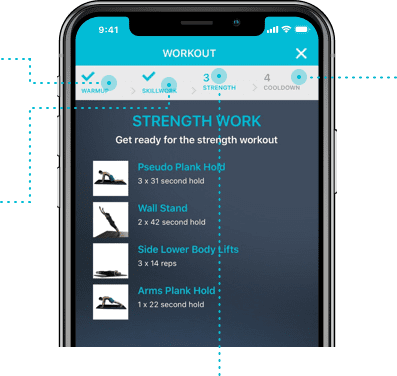
Strength, Endurance & Muscle work
Workouts alternate with strength
Cooldown & Flexibility
Our app uses advanced algorithms with tags and buckets of exercises that create varied and organized cooldowns, making sure you stretch out and mobilise muscles you just worked on
Strength
Strength movements or main movements are the reason we are here. These are the movements that will chart your progression through the world of calisthenics and bodyweight fitness. There is a large variation in strength movements, from easy to hard, low volume to medium/higher volume, dynamic to static.
Muscle
A bigger muscle has the potential to become a stronger muscle. Muscle movements are movements which are done at low-to-medium intensities and higher total volumes for the purpose of building muscle. The lower intensities also allow athletes to focus on the muscles involved and to get a good squeeze and pump. Many muscle movements are pulled from appropriate strength movements.
Endurance
Many calisthenics movements involve static holds. Endurance movements train the athletes capability to hold the body various positions. These are typically programmed to be easier than the equivalent strength movement holds. Instead, more work volume is added for more practice time.
Workouts are an important part of building muscle. Now let’s move to the second most important aspect – DIET.
PART 2 DIET:
Muscle Gain Law #2: Eat enough calories, and mostly whole foods
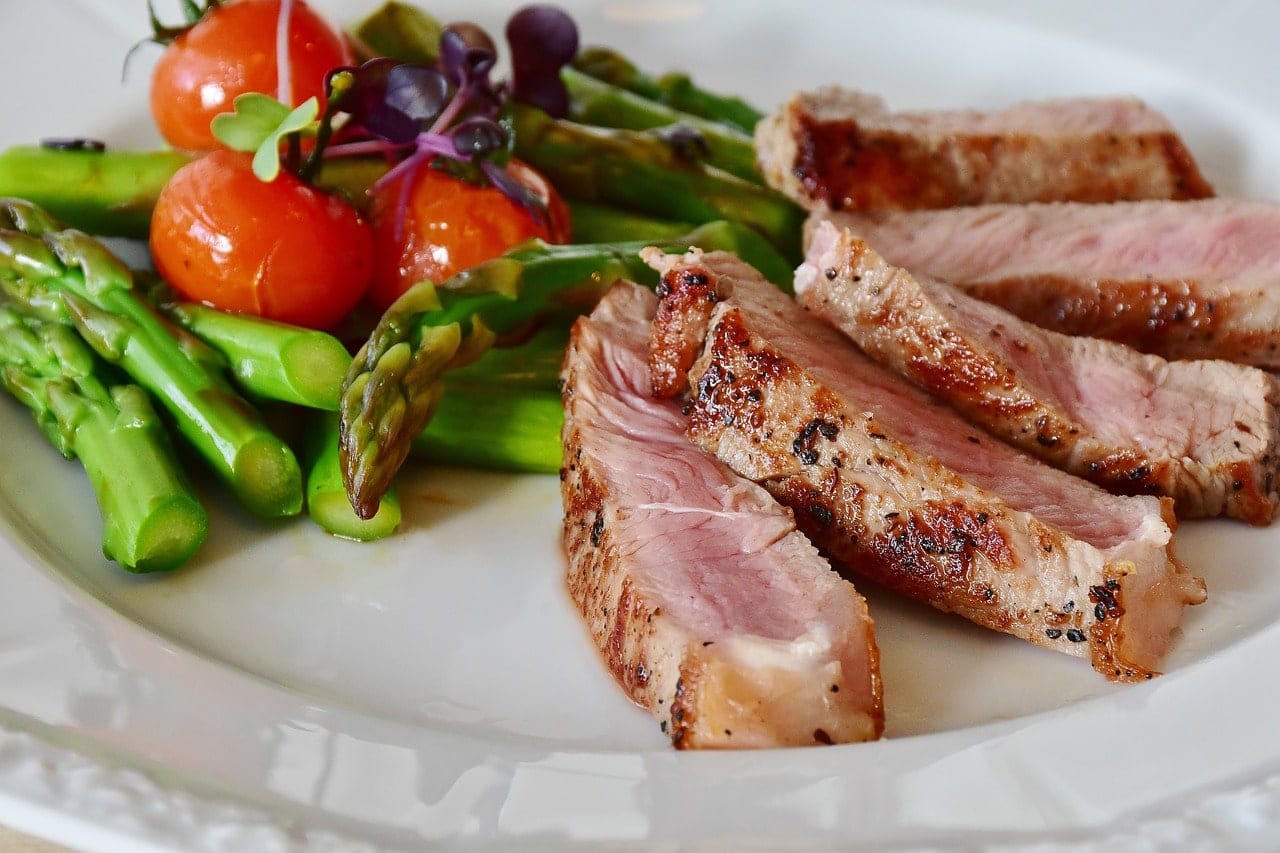
Most guys who try to gain muscle and fail focus way too much on their training, and not nearly enough on their diet.
A TON of guys just don’t eat enough food to gain muscle.
Period.
They’ll workout 6 times a week, drink a protein shake after each workout, have a light breakfast and lunch, and have a bowl of pasta for dinner… and think that’s enough.
We can almost guarantee you this – if you’ve worked hard, but struggled to gain muscle in the past, it’s almost certainly due to you NOT EATING ENOUGH!!!
So, how do you fix this?
Especially without gaining a bunch of fat?
NOTE: If you’re already overweight, or you gain fat easily, this next advice is doubly important for you.
How to figure out if you’re eating enough food
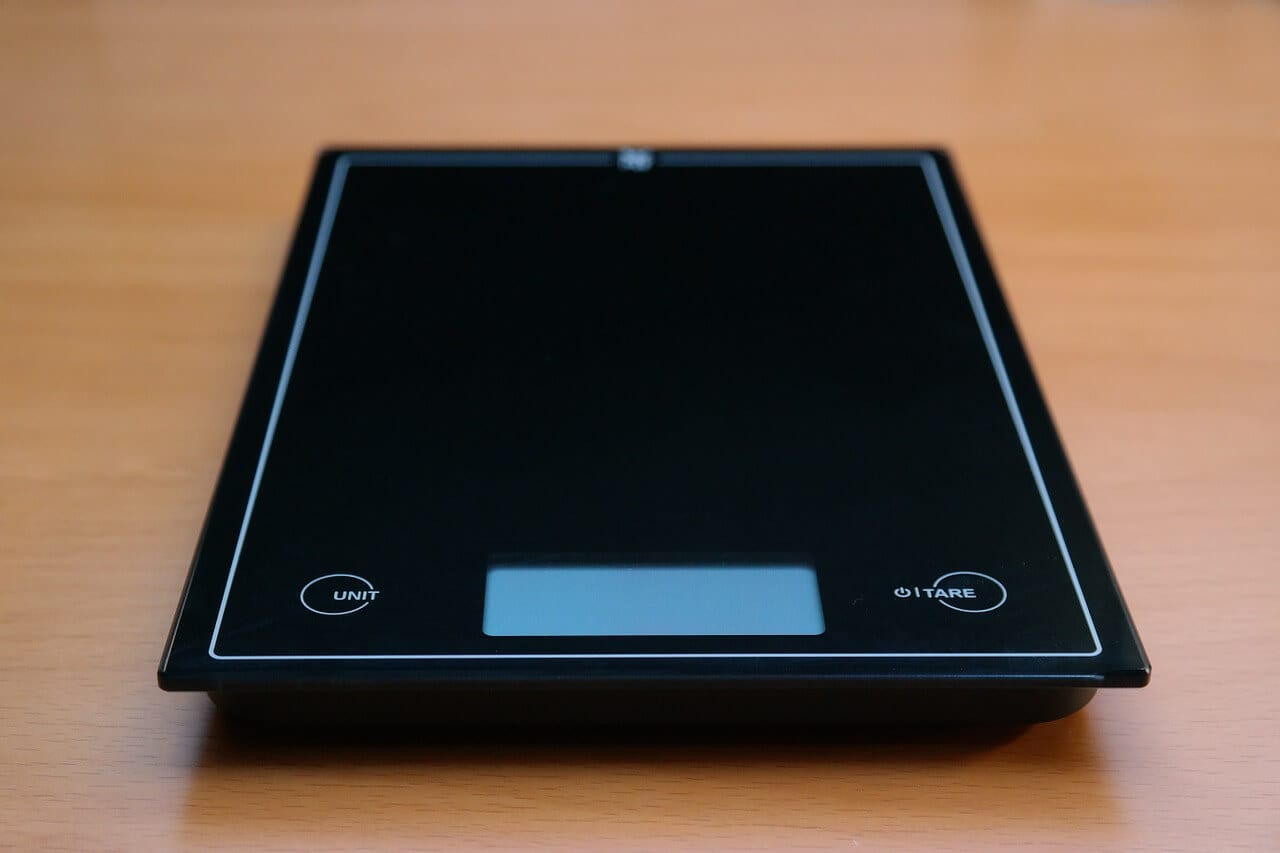
In order to figure out how much food you’re eating, you need to track your food intake – to the gram.
You need to track your food for at least 3-4 days.
So, first, track everything you eat using My Fitness Pal (yes they have apps and they are great) and a food scale. Do this for 2 weekdays and one weekend. Include alcohol, drinks – anything with calories.
Yes, this is anal, but if you want to gain muscle you need to do this at least once.
Now, take the average amount of calories you eat each day.
Compare it to the “muscle gain” setting on this calculator.
If you’re not hitting that number, you’re fucking it up!
It’s more than you think.
Typical calories required for gaining muscle
A moderately active guy who weighs 80 kilos (pounds?) and wants to gain muscle without gaining too much fat should eat 10% more than his body burns each day.
Which is about 2907 calories for a 70 kilos (155 pound) guy who’s 25 and who is 5 9’ tall.
If you’re eating lots of protein (as you should be) 2900 calories is A LOT. OF. FOOD. Especially if you’re eating your veggies and fruits (which you should be, as we’ll talk about in a second).
If you don’t gain fat easily, and feel like you have a super fast metabolism, you should be eating at least 20% more calories than you burn a day.
Which means you should be eating closer to 3172 calories.
Moral of the story: YOU NEED TO BE EATING ENOUGH!
You may not need to track everyday, but now you have a better idea of truly how much food it takes to gain muscle, especially if you have a fast metabolism. In which case you may have to eat even more.
Whole foods vs eating junk
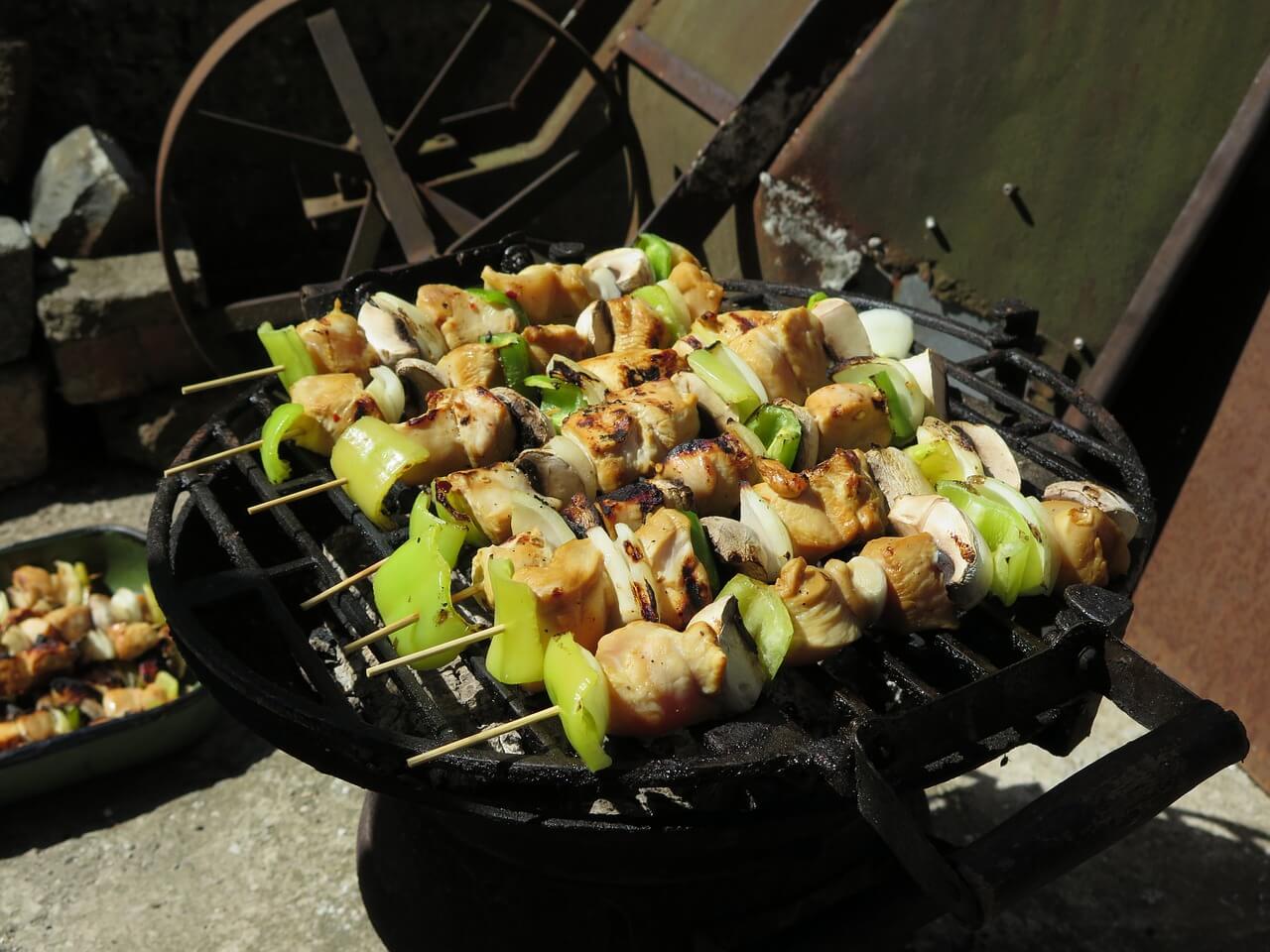
Now, we just got done saying that calories are king when it comes to gaining muscle.
However, you gotta eat plenty of protein, fruits, and vegetables as well.
Here’s why: these give you all the micronutrients your body needs to recover and rebuild properly.
Veggies are anabolic as fuck bro!
Plus, when you eventually hit your muscle gain goals, you won’t be addicted to drinking chocolate milkshakes everyday. You’ll look lean and muscular, not just big and fat.
How much protein, veggies, fruits?
Well, here are some good rule of thumb:
- You should eat protein and vegetables at every meal you consume.
- You should aim to eat 1 gram of protein per pound of body weight you have.
- And, you should eat at least 2-3 handfuls of fruit each day?
What if you have trouble eating enough food to gain muscle?
However, at the same time, it can be pretty hard for some guys to eat healthy. Especially if you’re having trouble getting enough calories in to begin with.
You want the FOUNDATION of your diet to be protein, veggies, and fruits.
Then, you can add in some calorie bombs to get the raw calories you need to build muscle – especially as a hardgainer.
FAIR WARNING: If you are prone to gaining fat, you should track your calories and eat around 10-15% more calories than you burn.
If you go apeshit and just eat junk food all day everyday, or even just way, way too much rice and potatoes, you can gain fat a LOT faster than you gain muscle.
So, if you tend to gain fat easily, you should probably track your calories.
However, if you are skinny as a rail, and you just can’t seem to eat enough food no matter what you do, you should just eat as much as possible.
You skinny fat guys can use these selectively with your calorie tracking to get in those needed calories at the end of the day.


Calorie Hack #1: Make big ass, thick, calorie bomb healthy protein shakes
Mix in tons of protein powder, some whole milk, some greek yogurt, some kale or spinach, some frozen berries, some cacao powder, and a nice amount of peanut butter.
Blend it up, and down this after each workout. You’ll get tons of calories in an easily digestible form.
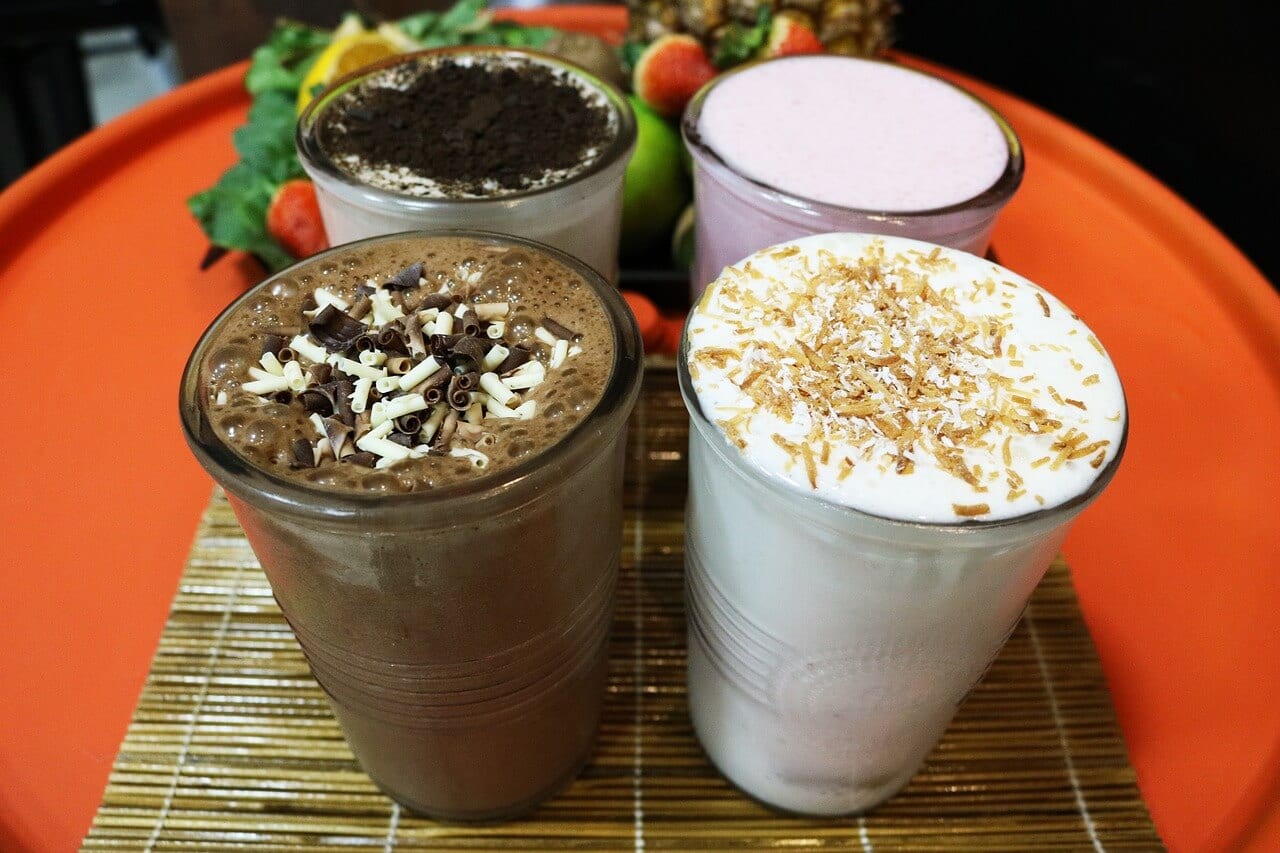

Calorie Hack #2: Selectively eat junk food
The best time to go HAM and eat an entire pizza is right after your workout. Your muscles are primed to soak up nutrients.
So, if you’re having trouble gaining weight, just select your favorite high calorie food, have a bit of protein and veggies on the side, and then eat as much as you can.
Pizza and pasta are great choices here. Lots of carbs.

Calorie Hack #3: Make sure to eat starchy carbs
Ketogenic diets are TERRIBLE for gaining muscle.
Fat loss is another thing.
But if you want to gain muscle, you need to be eating carbs – and lots of them.
Baked potatoes. Pasta. Lots of fruit. Pizza. Rice.


Calorie Hack #4: Eat more meals
Leangains is great.
Intermittent fasting is great.
But if you’re struggling to put weight on…
You need to be eating breakfast, and snacking throughout the day.
Wake up, and have a big plate of canadian bacon, some mushrooms eggs, toast, and some oats and fruit if you can eat it all.
Then, snack on fruit, protein shakes, pretzels and cheese, etc throughout the day.
Make sure to get your veggies in at main meals.
Putting all the nutrition pieces together
If you want to gain muscle, and you gain fat easily, you’re gonna need to start tracking your calories.
Otherwise, you run the risk of not eating enough, and wasting all of the time you spend working out, or eating too much, and getting more fat than muscles.
If you really don’t want to gain any fat at all, you can eat maintenance calories on your non-training days, and eat about 15-20% above maintenance on training days.
In any case, week to week, monitor your strength levels, appearance in the mirror, and weight.
Weigh yourself first thing in the morning, everyday. Every two weeks, take an average of your current weight.
If you’re not gaining weight after 2 weeks of measuring, you need to eat more.
Keep in mind: you can only really gain about 1-2 pounds of muscle a MONTH.
So, every two weeks, you should be looking at 0.5 to 1 pound of increased weight.
If you’re gaining much more than that, you’re probably gaining fat.
Less than that – EAT MORE!
If you don’t gain fat easily, eat more meals, and eat higher calorie meals. If you don’t do this, you’ll never see results.
Muscle Gain Law #3:
You Must Get Lots of Sleep – And Manage Your Stress

If you’ve stuck with us so far, this is the part that you’re most likely to blow off.
“Ahh, what does it matter? If I train hard and eat enough, I’ll gain muscle.”
My friend – that is not true.
Yes, you need to train hard, and eat enough.
But your muscles are NOT built during training.
Muscles are built during rest.
So, if you aren’t making your recovery (especially sleep) at TOP priority, you might as well just go back to wearing a size XS and forget about any muscle gains.
Sorry if that sounds harsh – but we don’t want you to waste any effort.
Muscle gain requires all 3 pieces of the puzzle to work.
Especially for you twitchy, nervous, fast metabolism hardgainers out there who are just as stressed as the rest of us.
Your most important recovery: sleep
If you don’t get 8 hours of sleep a night on average you are shooting yourself in the foot.
Or, shooting yourself in the biceps.
Without sleep, you’re never gonna grow.
Getting at least 8 hours of sleep a night will supercharge your muscle gaining efforts.
Because you’ll destress your body, and when you get enough sleep, your body releases muscle growing compounds into your bloodstream.
Sleep helps you get into an anabolic (muscle building) state.
If you don’t sleep enough, your stress hormones get ramped up, which puts you in a catabolic (breakdown) state.
Hormones are powerful. Just ask any steroid user.
OK, so let’s say you’ve accepted how important sleep is. But maybe you find it hard to get to bed, or to fall asleep.
We got you.
If you’re having trouble getting setup for
sleep, here’s what you can do:
- Schedule less shit on weeknights – you have sleep to get!
- Schedule things earlier, give yourself at least 1-2 hours before bed
- Set an alarm on your phone for an hour before your bedtime – and leave and go home whenever that shit goes off.
If you’re having trouble falling asleep, here are
some things you can try:
- Install f.lux on your computer, and Twilight on your android phone (Sleep mode for you iPhone users). This makes it so your screens are less likely to keep you up.
- Eat a big meal about 2 hours before bed, with tons of carbs. Carbs are good for sleep.
- Make your room colder. Turn on the AC, or put a fan on. Cold = easier sleep.
- Eliminate any sources of light in your bedroom. Any phone lights, charger lights, should be replaced or covered with tape. Light makes your brain think it’s daytime. Dark helps you sleep.
- Read or listen to podcasts before bed.
- Drink hot tea, or take a hot shower. Your body will cool itself down and get sleepier.
- Have sex, or masturbate. We all know it’ll help you chill out before bed.
- Take some L-theanine – it’s a compound found in tea that can help you sleep.
- Try to get up at the same time every day. Waking up at different times (even sleeping in on the weekend) messes with your internal clock. Pick a wakeup time and stick to it.
- Take 20 minute naps. You don’t even have to fall asleep. These are perfect for weekends. Just make sure to set a timer – naps longer than 30 minutes will fuck your sleep cycle up and make you feel groggy. Not every time, but a lot of the time.
- Try sleep meditations right before bed.
- First thing when you wake up, go outside shirtless and catch some rays. The sun on your skin will help your body set it’s internal clock.
How to manage stress

If you’re getting 8 hours of sleep a night, you’re ahead of the game.
However, what if you feels stressed the fuck out most of the time?
That can impact your ability to sleep – and your ability to gain muscle.
Here are some things that can help you reduce stress:
- Do some cardio. Yes, too much cardio can affect your gains. But a moderate amount (30 minutes) of moderate intensity cardio each day can do wonders for your stress levels. GO for a run, a fast walk, or a hike, or do some jump rope each day.
- Get more sunlight. The sun will also help you sleep better at night. Taking walks outside each day is a great way to move and get sun at the same time.
- Get into nature. Just being around trees and other plants will help you de-stress.
- Hang out with cool humans. Seeing friends is a great stress reliever – just don’t stay up too late while doing so.
- Meditate. This is one of the best ways to manage stress – check out this free app to get started.
What about muscle gain
supplements?

Image Credit: Total Shape https://totalshape.com/supplements/
Notice that we put this section last.
We did that for a very good reason – if you’re not committed to the above Laws of Gaining Muscle, you shouldn’t be buying a bunch of supplements.
However, if you’re trying your absolute best, and want a little help, supplements can be good.
Just remember: they’re not a replacement for training hard, getting your sleep, and eating plenty of good food.
Which supplements are best for you?
There are really only a few supplements that are worth your hard earned money.
- If you only have money for one supplement, get a high quality protein powder, and use it often. You’ll get the best bang for your buck there.
- If you really have trouble getting enough calories in, buy protein powder AND tons of protein bars. Eat a few a day.
- If you know you have trouble eating veggies with each meal, pick up a greens powder.
- If you don’t get plenty of sunlight (cold climate, winter season) pick up a vitamin D supplement.
- Finally, if you have trouble sleeping, or if you’re stressed the fuck out a lot of the time, pick up some L-Theanine and/or CBD oil.
Protein Supplements
The key thing to remember with protein supplements?
You get what you pay for.
If you want cheap food, buy cheap carbs (rice in bulk, pasta in bulk) and get cheap fruits and veggies at a farmer’s market.
But when it comes to protein, you want the good shit. Because protein is higher up the food chain, and so there’s a bigger difference in terms of good protein vs bad.
You don’t want to buy protein that comes from factory farmed cows. Save your money if you can’t afford the good stuff, and just buy more whole foods instead.
Protein powder
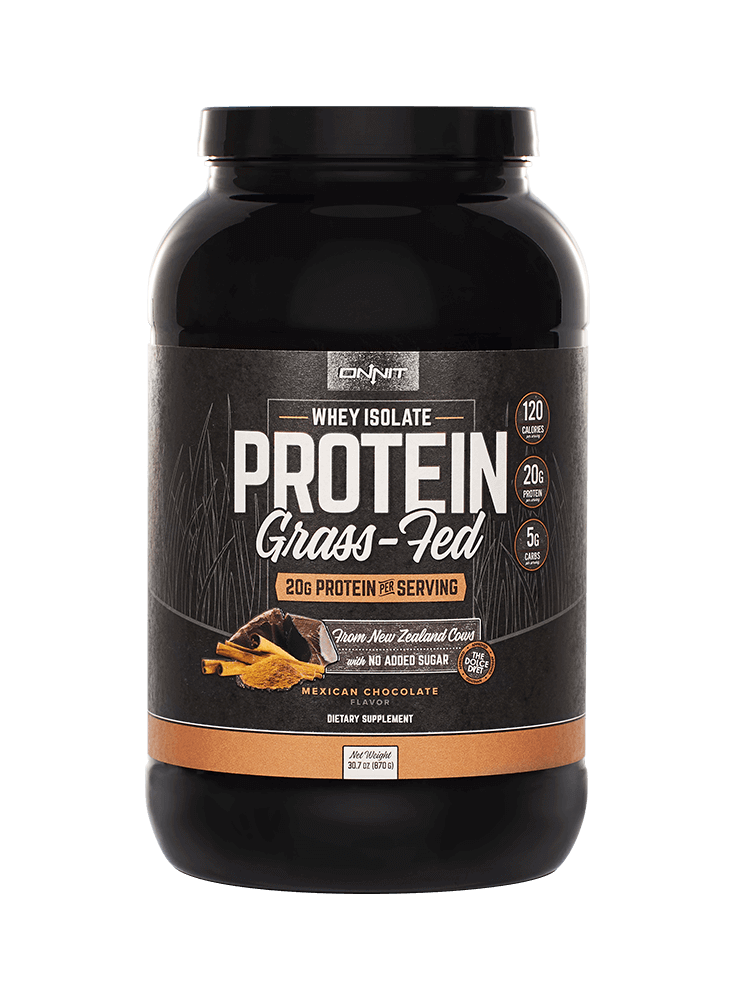
Number one, of course, is protein powder. Protein is essential for building muscle, and using protein powder helps you get more calories and protein in the easiest way possible.
This is pretty convenient, although bars are even better.
Protein powder really shines when you use it for healthy shakes.
There are tons of good powders out there, but you want one that uses grass fed protein. It’s just higher quality stuff, as cows were never meant to eat wheat.
This is one supplement where quality matters – yes, you can get protein powder at Walmart for super cheap.
However, half of that powder (and other cheap powders like it) is filler, or ingredients that you can’t pronounce that have no business being in your digestive system.
You get what you pay for in some areas, and protein powder is one of them.
Onnit makes a great protein powder at a reasonable price. You can pick it up here.
Protein Bars
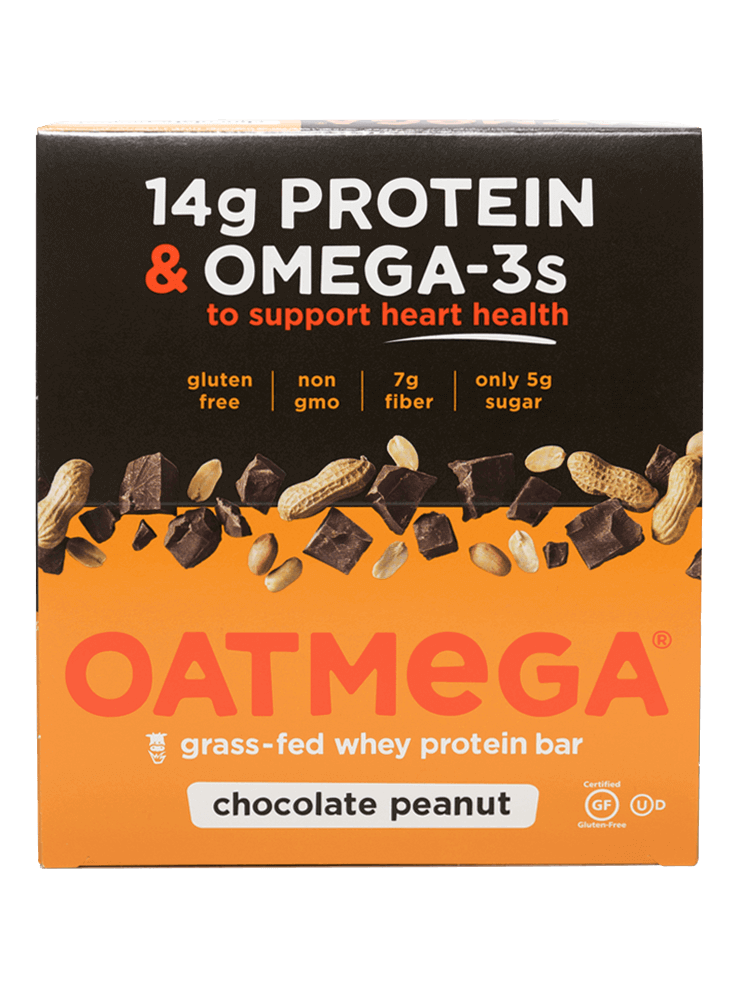
Protein bars are the fastest and most convenient way to get extra protein and calories throughout your day.
However, most protein bars are TRASH.
They either have way too much sugar, and are glorified candy bars….
Or they have weird sugar alcohols in them that will fuck up yoru digestive system.
The Oatmega bars are way better – they have tons of healthy omega 3s, and use grass fed whey protein as their base, with not much sugar and no weird ingredients that don’t belong.
Grab them here.
Again, you get what you pay for. If you can’t afford these, don’t buy cheap protein bars. Just buy more whole food, and meal prep like a motherfucker.
Health Supplements
Honestly, you should ONLY be spending money in this category if you’re absolutely trying your best to eat tons of fruits and veggies (as well as high quality dairy), but just have trouble getting them all in.
Real food will ALWAYS be a better source of nutrients than most supplements. The main exception being vitamin D – you need sun for that.
However, as long as you keep in mind that whole food is the key, supplements can be a nice icing on that cake.
Greens Powder

If you struggle to eat veggies with every meal, consider using Athletic Greens as a form of “insurance” to make sure you don’t have micronutrient deficiencies.
Still, it’s WAY better to just eat your veggies. But this is an OK substitute for days when shit hits the fan.
Vitamin D
If you don’t live in a warm climate, or if it’s winter for you, you should highly consider a Vitamin D supplement. Humans used to live outdoors, indoor living is pretty recent. And, so, we used to get WAY more sunlight than we do now.
This is a problem, because your body needs sunlight to produce vitamin D, an important hormone that can affect your muscle gain.
Get some vitamin D here.
Omega 3s
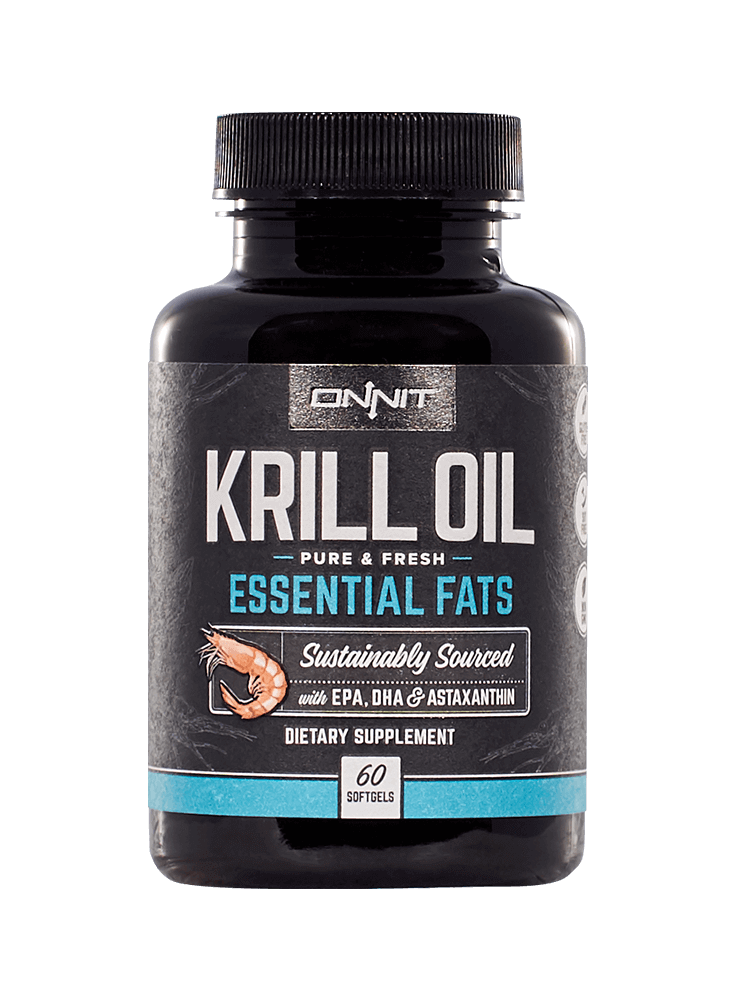
Omega 3 fatty acids are super good for your brain and your body. They help prevent heart disease, depression, dementia, and arthritis.
Fatty fish are a good source. However, due to mercury concerns, it’s probably best to not eat fatty fish every day.
So, you can use a krill oil instead, so you don’t have to worry about mercury.
Onnit, as always, has a great krill oil you can get here.
Stress Reduction Supplements

Modern life can be really fucking stressful.
And honestly, we could all use a bit of help in this department.
If you have less stress, your body will grow muscles more easily (and you’ll gain less fat).
Meditation
Yes, meditation isn’t a supplement.
But it’s damn useful even so.
Sam Harris’ Waking Up app is one of the best guided meditation apps we’ve found. It comes with a free trial – you should definitely check it out.
L Theanine
This magic amino acid is found in tea. Ever wonder why tea gives you more of a subtle boost, compared to the more “highs and lows” feeling you get from coffee?
A big reason for that is L-Theanine.
In studies, it’s been shown to help with alertness, relaxation, and focus.
Pick some up here. It’s pretty affordable.
CBD Oil
CBD oil is all the rage these days, and with good reason. Many people are reporting that CBD oil helps them reduce pain and inflammation, feel more calm and less anxious, and deal with insomnia.
So, if you want less stress, and better sleep, CBD oil could be great for you.
CBD does NOT get you high. Still, it’s illegal in some places, so check your local laws before buying it.
However, you should be really careful whom you buy CBD oil from. There’s a lot of shady shit out there.
Here are three very reputable suppliers that have independent labs checking their oils for quality:
Ready to gain muscle with calisthenics?

OK, now you’re ready to get on your way.
To briefly summarize, if you want to gain muscle with calisthenics, there are 3 Muscle Gain Laws you must follow.
- You must get stronger – without getting injured
- You must eat enough calories – and eat mostly whole foods
- You must get lots of sleep – and manage your stress levels
Refer back to this guide as often as you need to. It’ll always be free.
Finally, you should seriously consider signing up for our free calisthenics email course, The School of Strength.
You’ll get valuable lessons everyday for a week on how to build real world strength and muscle mass with calisthenics.
“Fitness is less of a thing I do, and more of a way to live”
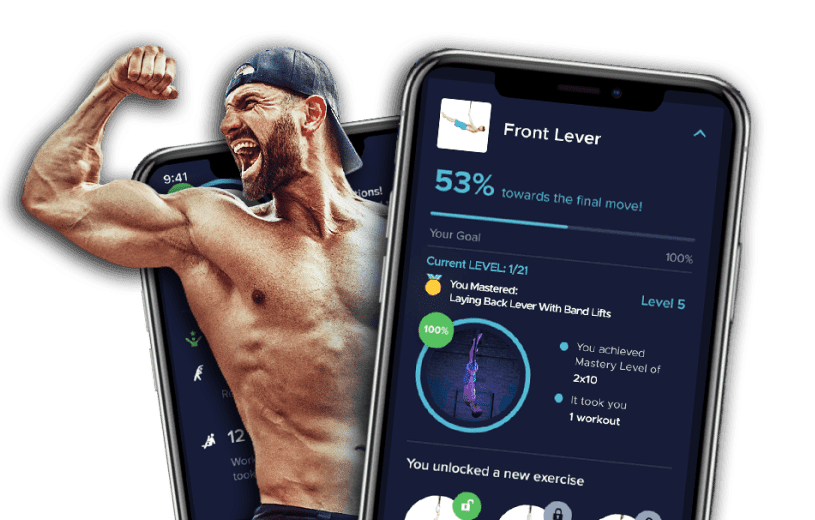
GET A FREE CUSTOMIZED TRAINING PLAN!
Start your life-changing journey with calisthenics and get lean, strong and mobile while unlocking and mastering over 100 new gymnastics & calisthenics skills.
It only takes 5 minutes, and no credit card is required!

